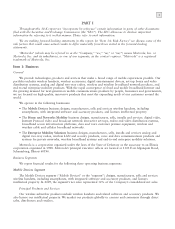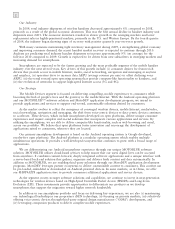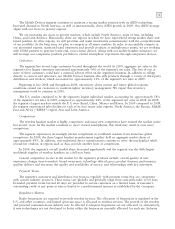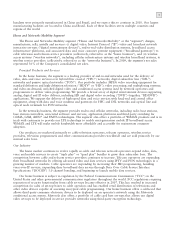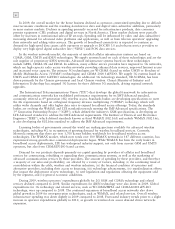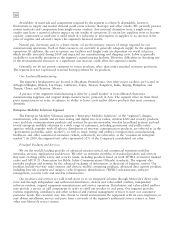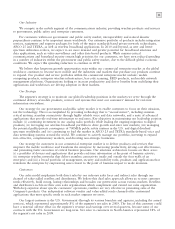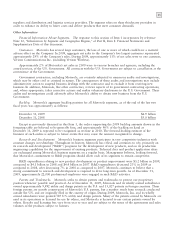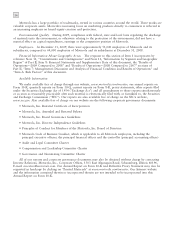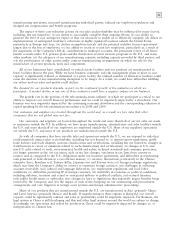Motorola 2009 Annual Report Download - page 19
Download and view the complete annual report
Please find page 19 of the 2009 Motorola annual report below. You can navigate through the pages in the report by either clicking on the pages listed below, or by using the keyword search tool below to find specific information within the annual report.
11
Our Industry
We compete in the mobile segment of the communications industry, providing wireless products and services
to government, public safety and enterprise customers.
For customers within our government and public safety market, interoperability and natural disaster
preparedness continue to be important issues worldwide. Our extensive portfolio of products includes integration
services, equipment and support packages for both of the major standards-based private network technologies,
APCO 25 and TETRA, as well as wireless broadband applications. In 2010 and beyond, as new and better
spectrum utilization evolves, we expect to see more demand and greater potential for broadband solutions and
data applications, such as video surveillance and other data-based products. While mission-critical
communications and homeland security remain high priorities for our customers, we have seen reduced spending
in a number of industries within the government and public safety market, due to the difficult global economic
conditions. We expect this spending reduction to continue in 2010.
We believe that long-term growth opportunities exist within our commercial enterprise market as the global
workforce continues to become more mobile and the industries and markets that purchase our products continue
to expand. Our product and service portfolios within the commercial enterprise market include: mobile
computing products, enterprise wireless infrastructure, bar code scanning, RFID products, and mobile network
management platforms. Organizations looking to increase productivity and derive benefits from mobilizing their
applications and workforces are driving adoption in these markets.
Our Strategy
The segment’s strategy is to maintain our global leadership positions in the markets we serve through the
continued delivery of mobile products, services and systems that meet our customers’ demand for real-time
information everywhere.
Our strategy for our government and public safety market is to enable customers to focus on their missions,
not the technology. This is accomplished by providing technology that is ‘‘second nature’’, including: mission-
critical systems, seamless connectivity through highly reliable voice and data networks, and a suite of advanced
applications that provide real-time information to end users. Key objectives in maintaining our leadership position
include: (i) continuing investment in our analog radio portfolio while leading the ongoing migration to digital
products; (ii) leveraging our wireless broadband portfolio to drive growth and enter new markets; (iii) managing
the potential public/private convergence of 700MHz public safety systems in the U.S. and digital dividend
spectrum worldwide; and (iv) continuing to lead the market in APCO 25 and TETRA standards-based voice and
data networking systems around the world. We continue to actively manage our portfolio, investing to expand
into attractive, complementary markets, and divesting non-strategic businesses.
Our strategy for customers in our commercial enterprise market is to deliver products and services that
empower the mobile workforce and transform the enterprise by increasing productivity, driving cost effectiveness,
and promoting faster execution of critical business processes. Our solutions architecture focuses on three areas:
(i) a portfolio of devices and applications that provide real-time information at the point of business activity;
(ii) enterprise wireless networks that deliver seamless connectivity inside and outside the four walls of an
enterprise; and (iii) a broad portfolio of management, security and mobility tools, products and applications that
transform the enterprise by empowering users closest to the point of business impact to make decisions.
Customers
Our sales model emphasizes both direct sales by our in-house sales force and indirect sales through our
channel of value-added resellers and distributors. We believe this dual sales approach allows us to meet customer
needs effectively, build strong, lasting relationships and broaden our penetration across various markets. Resellers
and distributors each have their own sales organizations which complement and extend our sales organization.
With deep expertise about specific customers’ operations, resellers are very effective in promoting sales of the
Company’s products. Our independent software vendor and value-added resale channels offer customized
applications that meet specific needs in each market segment we serve.
Our largest customer is the U.S. Government (through its various branches and agencies, including the armed
services), which represented approximately 8% of the segment’s net sales in 2009. The loss of this customer could
have a material adverse effect on the segment’s revenue and earnings over several quarters, because some of our
contracts with the U.S. Government are long-term. Net sales to customers in North America represented 58% of
the segment’s net sales in 2009.


